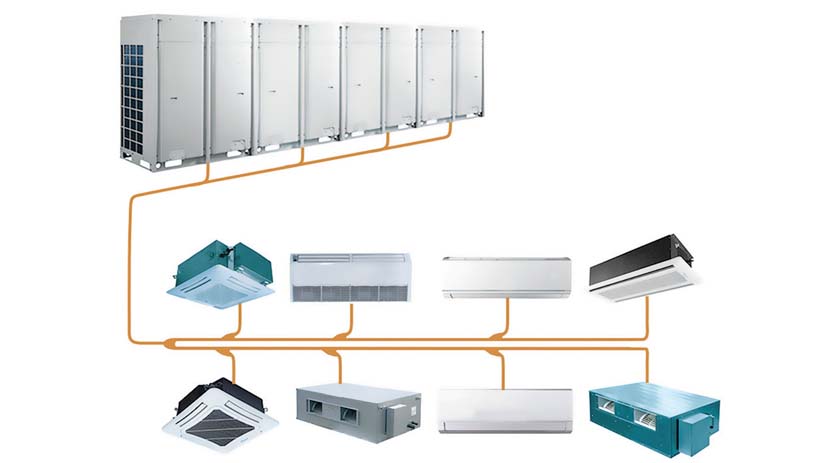Demand for VRF Systems is increasing owing to their capacity to conserve energy and increased applications across several industries.
A Variable refrigerant flow (VRF) system consists of many indoor evaporators connected to a single condensing unit using multiple split refrigerant systems. As a result of these systems’ increased capacity and related refrigerant flow adjustments, energy efficiency has been enhanced. These systems can be employed in buildings, educational institutions, healthcare facilities, hotels, and restaurants, in addition to the commercial sector. These methods improve efficiency and lower the energy consumption of HVAC systems.
Variable refrigerant flow systems modify the refrigerant flow to indoor units following the system’s needs. These systems can regulate and maintain the facility-wide refrigerant flow to a fan coil unit. The most popular forms of these systems are heat pumps and heat recovery systems. Depending on the need for simultaneous heating and cooling, they may be used in various applications. The demand for VRF systems is increasing due to several factors, including their capacity to conserve energy, provide design flexibility, and be installed affordably, making them an ideal choice for residential and commercial users.
Most commercial facilities, from tiny shops and cafés to large office buildings and public areas, employ VRF systems, boosting the market for these systems’ growth, revenue, and market share. With VRF zoning, energy usage is restricted to cooling or heating-occupied workplaces. VRF systems offer the most comfortable and practical working environment since they feature silent interior units and can maintain precise temperature control. The VRF heat pump systems market for residential applications will be driven by rising energy prices, increased disposable income, and growing awareness of energy saving. Due to these factors, there is an increasing need for energy-efficient machinery that may help reduce energy consumption and expenses. Due to all these factors, the global VRF Systems market is estimated to reach a valuation of USD 41.3 Billion by 2030, expanding at a CAGR of 12.40 percent during the forecast period of 2021–2030.
Rising urbanisation to drive growth
Urbanisation and technical developments drive the market growth for VRF systems and the VRF systems market. Similar to the previous market, this one is being pushed by rising construction activity and the creation of energy-saving goods and technology. The popularity of wireless control systems by people and enterprises for monitoring indoor units throughout homes, offices, and referral regions is another factor driving the market share for VRF Systems. Over the projected period, the need for energy-efficient resources is expected to grow along with environmental consciousness and building activity. VRF systems offer unique controls for each housing unit, making them incredibly energyefficient and inexpensive to operate. As a result, more and more building owners and managers are choosing VRF air conditioning.Due to its longer product life in challenging conditions, excellent air-conditioning performance, and exceptional service, VRF systems are the best option for apartments and communal housing.
High investments hold down growth in developing regions.
High investment costs and a lack of knowledge about the advantages of VRF systems limit the market’s air-conditioning performance, and exceptional service, VRF systems are the best option for apartments and communal housing.
High investments hold down growth in developing regions
High investment costs and a lack of knowledge about the advantages of VRF systems limit the market’s growth. The hefty maintenance expenses related to filters are stifling market expansion. High installation and maintenance expenses, abuses of human rights, economic concerns, and a shortage of instructional materials limit the market share of VRF Systems. The sluggish digitisation rate in developing countries affects how widely VRF systems are used globally throughout the forecast period.
The region with the largest market share throughout the historical forecast period is Asia-Pacific, which is also expected to increase over the projection period. One of the factors propelling the growth of the VRF Systems market in the AsiaPacific region is the rising demand for VRF systems from residential and commercial end-users. The need for high-tech products like wireless and connected devices and growing urbanisation and industrialisation are other factors driving the VRF Systems market. The presence of several producers, including Daikin Industries Ltd.,Fujitsu Limited, Mitsubishi Electric Corporation, and others, is another factor driving the industry.
However, the North American region is anticipated to develop at a significant CAGR over the projected period due to commercial organisations’ growing acceptance of VRF technology for energy savings and flexible designs. The market is expanding due to the growing integration of connected technologies.
A small number of significant rivals now control the market regarding market share. The industry’s top players are focusing on expanding their customer bases to new regions. To provide a range of affordable products, the major players keep innovating and spending money on R&D. Recent mergers and acquisitions among the big players have been the strategies; companies employ to increase their customer base.
Inputs by – Market Research Future
Variable refrigerant flow (VRF) – https://www.
Cookie Consent
We use cookies to personalize your experience. By continuing to visit this website you agree to our Terms & Conditions, Privacy Policy and Cookie Policy.














